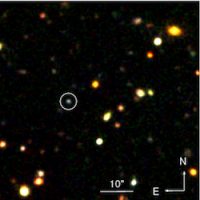 |
An international research team, led by Edo Berger of Harvard-Smithsonian Center for Astrophysics, made the most of a dying star’s fury to probe a distant galaxy some 9.5 billion light-years distant. The dying star, which lit the galactic scene, is the most distant stellar explosion of its kind ever studied. According to Berger, “It’s like someone turned on a flashlight in a dark room and suddenly allowed us to see, for a short time, what this far-off galaxy looks like, what it is composed of.”
CfA Press Release
|